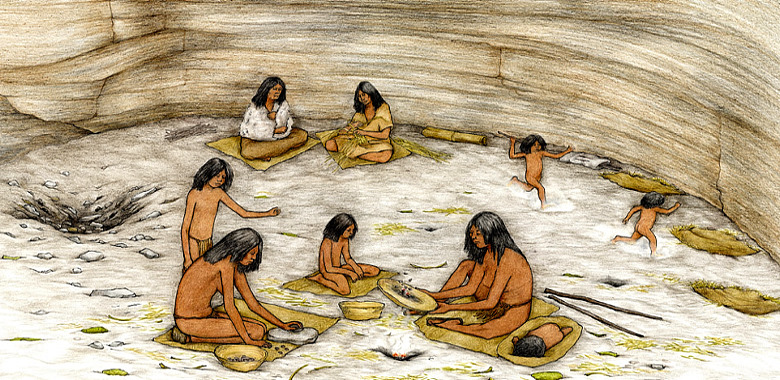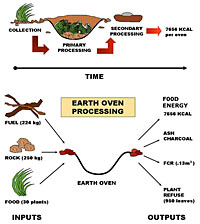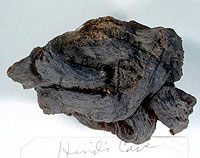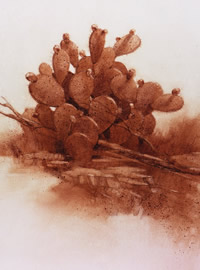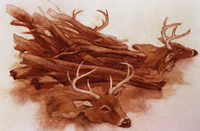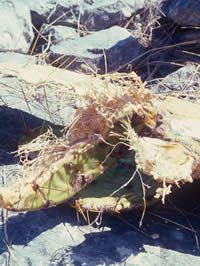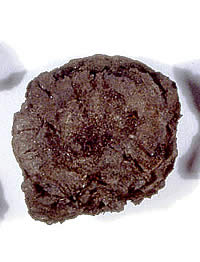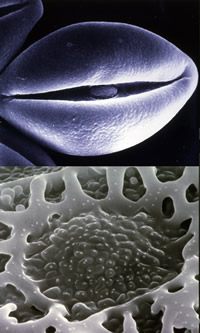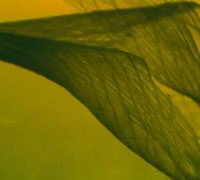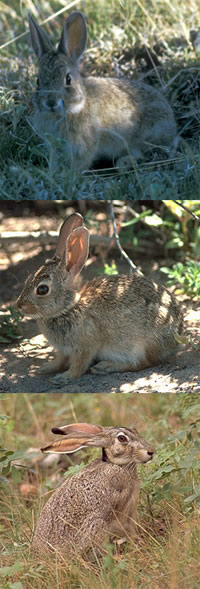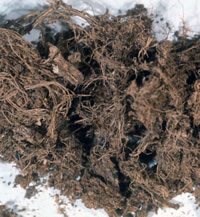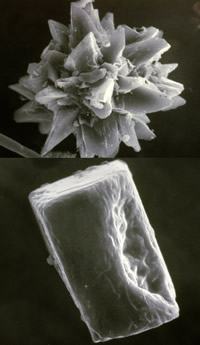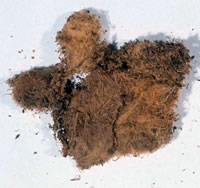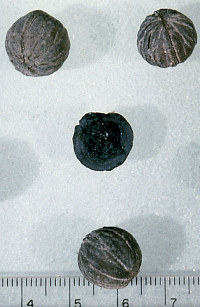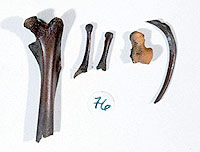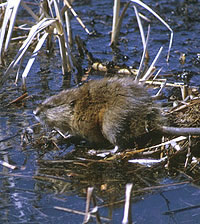|
In this section:
|
| |
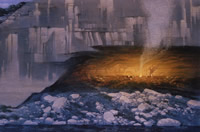
Artist's depiction of ritual life in a Lower Pecos rockhelter. Over the flickering flames of campfire a shaman cast his shadow on the back wall, where rock art murals echo his spiritual journeys. Although the walls of Hinds Cave were too rough for rock art, ritual life must have played out here too, even if archeologists didn't uncover any obvious evidence of it. Painting by George Strickland, courtesy Witte Museum of San Antonio. |

Artist's depiction of a canyon scene in the Lower Pecos Canyonlands. The women uses a digging stick as a staff as she makes her way along a rocky tray. Around her head is a woven tumpline leading to the carrying basket on her back. In the background two of her children follow along and help mom on her daily round of gathering. Drawing by George Strickland, courtesy Witte Museum of San Antonio. |
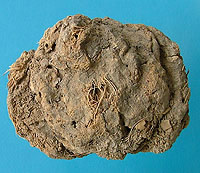
This is what it looks like—a "patty"— but this one was left behind in Hinds Cave by one of its former human inhabitants. Coprolites—dried human feces—represent an extraordinarily direct line of dietary evidence. This specimen is full of fiber, but it looks like it was less than solid when deposited. Such is life. TAMU Anthropology archives. |
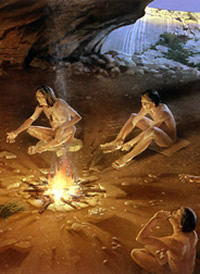
Artist’s rendering of an evening campfire and meal at a Lower Pecos rockshelter. Painting by George Strickland, courtesy of the Witte Museum.
|
| |
|
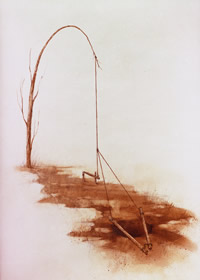
Spring snares were among the devices used to trap the small animals that lived in the Hinds Cave canyon. An artifact thought to be part of a share—a once-springy branch and attached thin cord—was found at Hinds Cave. Drawing by George Strickland, courtesy Witte Museum of San Antonio.
|
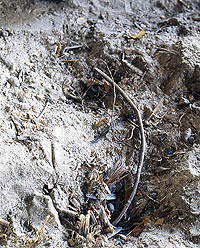
The remains of a small snare as found in a fiber lens in Area C. TAMU Anthropology archives.
|
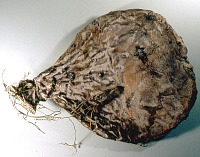
Prickly pear pads were used for food, for packing material in earth ovens, and as floor coverings. The spines have been singed off this specimen and those found in the layer thought to represent an intentional floor covering that may have served mainly to hold down dust. TAMU Anthropology archives. |
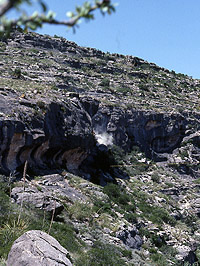
Excavation dust rises from the mouth of Hinds Cave in 1976. TAMU Anthropology archives.
|
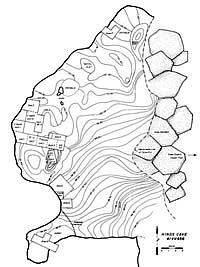
Detailed map of Hinds Cave showing topography, physical
features and excavation areas. The contour interval is 75 centimeters. The
line marked "Approximate Line of Talus Fill" coincides
with the drip line of the shelter overhang. Adapted from Shafer and Bryant
1977. |
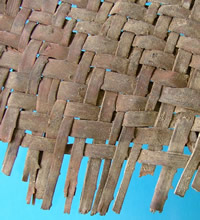 Detail of mat woven from sotol leaves. TAMU Anthropology archives. |
. 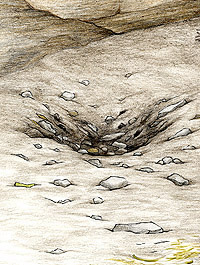 "Sotol" or earth oven pit. Detail of illustration by Peggy Maceo. |
| |
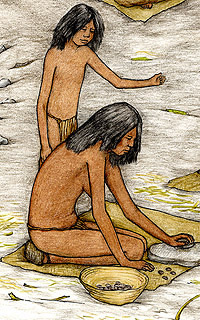
A girl watches and learns as her mother uses grinding stones to crush charred nuts. Detail of illustration by Peggy Maceo. |
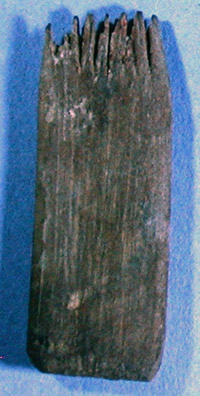
Wooden comb with traces of red ochre from the Speck collection, Hinds Cave. It is not known whether this artifact was used for grooming hair or some other purpose. TAMU Anthropology archives.
|
Hinds Cave has yielded a wealth of potential evidence of seasonality because people brought plant materials and foods into the cave that were available only during certain seasons. |
| |
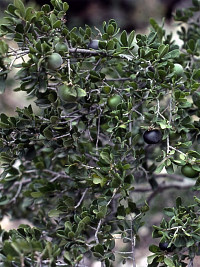
The fruits of the Texas
persimmon ripen in late summer. This small tree or shrub would have
grown thickly in the canyons. Seasoned persimmon wood is dark and dense, and was used to make digging sticks and other tools. Photo by Phillip Williams. TAMU Anthropology archives. |
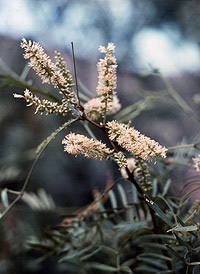
Mesquite flowers normally appear in spring. The beans (seeds) are ripe in August and September. TAMU Anthropology archives. |
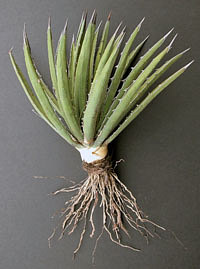
Lechuguilla plant with a few outer leaves removed to show the white inner leaf base, the leaf part that is edible. The plant is well armed by spines at the tips of the leaves as well as along the sides, earning the nickname "shinbuster." Photo by Phil Dering. |
|
Here we summarize what has been learned
about daily living at Hinds Cave. Boiling down the
story of 9,000 years of intermittent use of the site leaves us
with a picture of a way of life very different from that which
we enjoy today. Generation after generation of native peoples—all
told at least 350 generations—made their living in the region by hunting and gathering.
Yet, this way of life was not fixed or identical for each group and each period. Researchers are only now beginning to accumulate
enough data to ferret out the finer changes
and trends through time. In the next few decades, archeologists should be able to explore the details and develop
more sophisticated understandings of the ebb and flow of human
life over thousands of years at Hinds Cave and
so many other localities in the Lower Pecos Canyonlands.
Hunter-Gatherer Life
All of the peoples who stayed at Hinds Cave in prehistoric
times lived off the land and followed a nomadic lifestyle known
to anthropologists as hunting and gathering or foraging. Based
on what is known about similar peoples elsewhere,
the basic social group would have been an extended family band of 10 to 25 people. Band members were closely related to one another by kinship ties,
some genetic, some through marriage. Family bands would have consisted of some combination of grandparents,
parents, children, aunts, uncles and cousins.
Related family bands would have periodically joined together in
larger groups of up to 100 people or more on social occasions that
coincided with seasons of abundance, such as the late summer/early
fall ripening of prickly pear tunas, persimmons, and walnuts. Family
bands were related to one another through kinship, shared history,
and language. Anthropologists sometimes call these larger groups
macrobands. Each group, large and small, would have had its own identity, traditional
territory, and unique name, which we—thousands of years later—will never know. Only individual family bands would
have occupied Hinds Cave, but the cave may have been used by several
different family bands who shared partially overlapping territories.
Hunter-gatherer life is highly mobile, especially in environmentally challenging
areas such as the Lower Pecos Canyonlands. People
could not live in one spot for long without exhausting the local supplies
of food and firewood. Instead they must have moved their camps
quite regularly—every few days or weeks—to take advantage
of the resources changing with the seasons and during short-term climatic events. Part of the mobility was tied to seasonal rounds—moving across the landscape to areas
where different food resources could be found in abundance certain
times of the year. For instance, native pecan
trees grew in the deep sediments of the terraces along the
Devils River and other rivers and streams farther east that drain the Edwards Plateau. Pecan nuts ripen
in the fall and are much more abundant in some years than others.
Hunter-gatherers would have monitored the natural crop and planned
for particularly good harvests months in advance. When the season
came, groups would have moved camp to the prime areas.
But the changing seasons only tell part of the mobile lifestyle
story. In the arid Lower Pecos Canyonlands, climatic events can
be extremely localized and must have triggered movements
of people just as they do the movement of certain animals today. As area ranchers
know only too well, warm-season thunderstorms often fall in only
small areas or narrow swaths in this country. When one spot gets
more than its share of rain, plants bloom, shrubs and trees leaf
out, and grasses green up and grow thickly. Deer and other mobile
animals from miles around can move in quickly to take advantage
of localized abundance, especially during droughts and otherwise
tough conditions. Hunters and gatherers would have been equally opportunistic.
The people lived mostly outdoors in open campsites along the river
terraces and in the uplands overlooking the canyons. The main shelter
needed most of the year was simply shade from the intense sun.
This was provided by constructing crude makeshift dwellings and
ramadas (shade arbors) with pole frameworks covered with whatever materials
were at hand: leafy branches, bundles of grass, woven mats, or
hides. We can infer this, paradoxically, from the absence of archeological evidence of
substantial structures and also because brush huts and ramadas were
seen by the early Spanish explorers in the region. Similar makeshift
structures have been documented during more-recent historic encounters
with many native groups living comparable lifestyles in northern
Mexico and the western United States.
When substantive shelter was really needed during wet,
cold, and extremely windy weather, the peoples of the Lower Pecos
Canyonlands could always seek temporary refuge in natural shelters
such as Hinds Cave. Some archeologists think the main occupations
of the dry rockshelters may have occurred during times of inclement
weather. The evidence from
Hinds Cave, however, suggests this particular shelter was used throughout
most of the year, especially during the warm-weather months. Rather than a retreat, Hind Cave probably served more often as a convenient
camping spot for family bands seeking out the resources of
the canyon and nearby landforms.
Use of Hinds Cave
We infer that Hind Cave served two principle functions during
most of its use life in prehistoric times—as an occupational
shelter and as a sheltered place to keep firewood, heavy tools like manos and metates, wooden tools, and small caches of food. It was not, however,
occupied permanently or continously throughout the year. Like other caves and
rockshelters in the region, it was used periodically and seasonally
by the bands whose territories included the shelter.
With its large overhang and overall size Hinds Cave did afford
ample protection from rain, although only the small alcove area
(the actual “cave” part) was naturally insulated from
cold and wind. Large rockshelters were more than mere places where
people sometimes lived. Hind Cave and other dry shelters were also
used for dry storage, as caching places for domestic equipment, ritual equipment,
and fuel, as well as final resting places for the dead. And, of
course, the smooth walls of many shelters and overhangs in the
Lower Pecos were used as natural canvases for painted scenes strongly
linked to ritual. Hinds Cave probably served as a ritual setting from time to time, but it has particularly rough, uneven walls that seem never
have to been painted. But it probably served all of the other functions
mentioned above.
There is no reason to think that
Hinds Cave or any other shelter was used for all of these purposes
at any point in time. Although the large shelters must have been
permanent, named places on the human landscape, through the centuries
and millennia they were used to meet many different needs. Outstanding
shelters such as Hinds must have been well mapped into the folklore
and mythology of the people, thereby passing on the cave’s
legacy to each generation.
Like virtually all of the dry shelters in the
Lower Pecos Canyonlands, artifact collectors removed most of the
perishable equipment and burials Hinds Cave once held. Most equipment—mats,
basketry, rabbit nets, digging sticks, grinding stones, and the
like was presumably stored only temporarily between uses, yet over
time things did get left behind. Some things must have been forgotten
or abandoned because they were no longer needed or their condition
deteriorated beyond usefulness. There is also evidence that unrelated
Indian peoples from the Plains moved into the region and displaced
its traditional inhabitants during late prehistoric and early historic
times. Such catastrophic cultural changes must have also led to
abandoned equipment and severed traditions.
We know the dry shelters were used to store equipment and house
burials because many items and some burials were found, documented,
and removed by early museum expeditions and archeological excavations
beginning in the 1930s. Minimal documentation also exists for materials
that some private collectors have donated to museums and for some
materials that archeologists have studied from private
collections.
Natural shelters such as Hinds Cave may also have been used to
stockpile firewood in anticipation of periods of wet weather. This suspected habit would have made it possible
to carry out cooking during extended wet periods, especially the use of earth
ovens to bake the hearts of semi-succulants such as lechuguilla
and sotol. Earth oven cooking requires considerable firewood and
probably was most important during the late winter and early spring
when few other foods were available and stored foods were gone.
Cold, wet stretches coinciding with an annual dietary low point
would have made efficient earth oven cooking next to impossible
except in naturally sheltered locations.
Floor coverings. Because the interior of the cave remained dry even in the worst
storm, it was very dusty. No moisture could penetrate the protected
floor and wind erosion of the soft limestone strata from which
the cave is formed created a fine dust layer on the natural floor.
When the natural dust was combined with wood ash from warming and
cooking fires, clouds of dust were created simply by walking across
the floor. To combat this rather inhospitable condition, groups
at different times seem to have covered parts of the floor of the cave with layers of plant materials.
In the Early Archaic, sizable floor sections were covered on two separate occasions with prickly pear pads
with spines removed. At other times,
grasses, and oak leaves were used to cover the floor, perhaps in
hopes of holding down the dust and making the cave more livable.
Living space. The large size of the covered overhang provided living space
and enough work space for the construction of earth ovens.
The steep slope in the front portion of the floor, however, limited
the actual living space. Based on the available floor area of the
relatively flat central rear portion of the shelter and a tiny
space in the alcove, there are perhaps 65-70 square meters (700-750
square feet) of prime space for basic habitation (sleeping, warming
fires, and ordinary cooking fires). It is estimated that Hinds
Cave was occupied by groups of no more than 12 to 15 people
at any one time. More could have crowded in during a bad storm or a
special occasion, but not for long.
Clues as to the organization of living space have come from excavation observations and specialized analyses. Sleeping areas near
the back of the cave were identified by the presence of beds. These
beds were made by digging shallow pits and lining the bottom with
green boughs (small leafy branches). Woven mats or petate fragments,
prickly pear pads (with spines removed), and discarded sandals
were placed as a padded layer over the bows. Grass was used to
fill the pit and this layer was probably covered by a sleeping
mat when the beds were in use. These beds varied in size, depending
on the size of the person. An adult’s bed measured slightly
more than three feet in length and perhaps two feet across. Why
so small? To conserve body heat, the people who stayed at Hinds
Cave slept in a flexed position, just like many of us do today.
Extensive deposits and lenses of white ash were encountered across
the living areas of the site. We assume some of the white ash was
the result of warming fires allowed to burn and smolder. Placing
warming fires in front of the sleeping area, and heating rocks
to generate heat would certainly help one to survive a wintry night
in Hinds Cave.
Earth ovens used to bake lechuguilla, sotol, and prickly pear
pads were constructed near the front of the north end of the cave. At least two large burned rock middens and associated
pit ovens were present within the overhang. Other burned rock layers
were encountered in the living area as well. Hinds Cave has some of the earliest evidence for earth oven cooking yet documented
in the Lower Pecos Canyonlands.
Latrine deposits were recorded on the slope along the west wall
west of the main living area. The largest and most permanent latrine
was found on the break of the slope at the front of the living
area (Area B). While an occasional coprolite was recovered in the
living area, there is little doubt that certain areas within the
overhang, but on the edges of the main living space, were set aside
as latrines. The Area B latrine seems to have been used repeatedly
over a several thousand year span during the Early Archaic and
perhaps later.
Clothing and Attire
During much of the year hunting and gathering peoples living in
arid lands have very little need for clothes. They did not have
the same attitude about modesty that most of us do today. Adult
men probably wore simple loin cloths of fiber or leather, and women
wore small apron-like fringe garments or deer skin skirts
and little else. Deer and bison hide garments have been described
historically for hunters and gatherers in central northern Mexico,
but no such garments have ever been recovered in the dry shelters
of the Lower Pecos. Children must have usually gone naked. During
the few cold months of the year (December-February), animal hide
coverings would have been used by all, especially rabbit fur robes.
Rabbit skins were cut into strips and twisted around a fiber cord,
and woven into blankets or robes. Deer and bison hides may have
been used as well, but there was no direct evidence of this at
Hinds Cave.
Few fragments of any kind of clothing were found at Hinds Cave
with one exception: fiber sandals. Worn-out sandals were among
the most common fiber artifacts recovered from the Hinds Cave
excavations. From the dozens and dozens of sandal fragments, we
surmise that everyone big and little wore sandals woven of locally available plants.
Leaves and fiber of yucca and Agave lechuguilla were the preferred
sandal-making materials. Sandal styles changed through time and
one manufacturing technique replaced another with the ebb and flow of human generations.
We do not know the hair styles of the Hinds Cave occupants,
and the styles probably varied through time. Human hair was a valuable
fiber used for nets and textiles throughout the
desert Southwest. Men and women may have used their hair to meet such needs.
Women may have worn their hair cropped or braided, while men’s
style probably varied more widely, depending on the group and time
period. Interestingly, one small wooden atifact with a comb-like working end caked with red ochre
was found at Hinds Cave.
It is very likely some of the Hinds inhabitants were tattooed. Tattooing
was a way of marking social group affiliation and marital status
among desert hunters and gatherers in southern Texas and north-central
Mexico. In earliest historic times, face and body painting was not uncommon among native groups
in the desert, especially when visitors were anticipated. These patterns probably represent traditions that stretch back thousands of years.
Seasonality
It is often very difficult or impossible to accurately determine the time(s) of
year that a prehistoric archeological site was occupied, especially
open campsites with poor preservation conditions. Fortunately,
Hinds Cave has yielded a wealth of potential evidence of seasonality because people
brought plant materials and foods into the cave that were available
only during certain seasons.
The big difficulty in determining
seasonality at Hinds is that desert plants do not respond to
the time of year as much as they do to rainfall. High annual variability in the amount and
timing of rainfall means that plant growth is sporadic. Years can
go by between the appearance of some species and between periods
of abundant growth. For many plants, flowering and fruiting cycles
can occur most anytime between early spring and late fall. Therefore,
precise seasonality determinations are not always possible even
with excellent plant preservation. Analysts
must qualify their seasonality assessments with phrases like “assuming
average conditions.”
Under “normal” conditions wild persimmon fruits,
for example, become available during the late summer (July and August). When abundant
persimmon seeds and fruit parts are recovered from the cave deposits or coprolites,
archeologists assume that late summer is the most likely season the remains
were deposited. Prickly pear fruits from June to September, but may last to October. Mesquite
seed pods ripen in August and September. Walnut and acorns ripen at the close of the warm season, from early
to late fall.
Prickly pear pads
(technically, stems) are available year-around and are not good seasonal indicators. The same is often said about sotol and lechuguilla, but we doubt
this was the case. While it is true that the leaf
bases and “hearts” of mature sotol and lechuguilla
plants can be rendered edible any time of the year, these plants
are marginal food resources even at the best times of the year. That
is, the amount of energy that must be expended to harvest and eat
these plants is almost equal to the amount of energy the cooked
plants yield. Drought stressed plants would have simply not been
worth the trouble. Therefore, it is much more likely that these
plants were mainly harvested during optimal conditions, just prior
to blooming. Normally, these plants bloom in the spring, thus they
are at their nutritional peak in late winter and early spring,
precisely the period when most other plant and animal foods are
scarce or unavailable.
There is another indication that Hinds Cave was sometimes used
during this same, early spring season: the use of live oak leaves
for flooring and possibly for bedding. Live oaks drop their leaves
in advance of flowering and pollinating at the onset of spring
in March. The large quantities of live oak leaves found in
certain Hinds Cave deposits, strongly suggest that this was one
season that the site was occupied.
Taking these factors together, the overall indications of seasonality represented
in the preserved plant materials suggest that Hinds Cave was occupied intermittently
at different times thoughout the year. The strongest seasonal evidence points to
warmer monsoon months from April-October. Late winter-early spring
(February-March) is the logical seasonal peak of lechugilla and sotol baking, of
which there is ample evidence. Definitive evidence
of late fall and winter (November-February) occupation is very hard to recognize. Few resources have seasonal peaks in those lean months when stored foods would have been highly valued.
|

Hinds Cave looking northwest from across the canyon. TAMU Anthropology archives. |

A glancing ray of early morning sunlight highlights the remains of a grass-filled pit thought to represent a child-size sleeping bed. The people who stayed in Hinds Cave slept in the fetus position as evidenced by their small oval beds. TAMU Anthropology archives. |
| |
Family bands were related to one another through kinship, shared history, and language. Anthropologists sometimes call larger groupings macrobands. Each group, large and small, would have had its own identity, traditional territory, and unique name, which we—thousands of years later—will never know. Only individual family bands would have occupied Hinds Cave, but the cave may have been used by several different family bands who shared partially overlapping territories. |
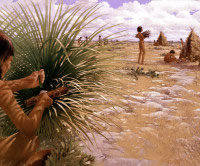
Artist's depiction of a camp in the uplands such as the terrain overlooking the Hinds Cave canyon. The brush shelters may look flimsy, but they were mainly needed to create shade from the intense sun. the woman in the foreground is trimming sotol leaves, perhaps to use them for weaving a new sleeping mat. Painting by George Strickland, courtesy Witte Museum of San Antonio.
|

Schematic drawing showing an idealized model of how the living space in Hinds Cave was used by Early Archaic peoples. Image courtesy of the Witte Museum.
|

The limestone wall of Hinds Cave is pitted and uneven, totally unsuited for the vivid rock art found on the smooth walls of many dry rockshelters. TAMU Anthropology archives.
|

Artist's depiction of a woman morning the loss of her infant, who is wrapped in finely woven mats. An infant burial is said to have been found by a collector at Hinds Cave. Fragments of the mat wrap were radiocarbon dated to about 200 B.C. Drawing by George Strickland, courtesy Witte Museum of San Antonio.
|

A small flat stone found in association with ash and charcoal may have been used as a griddle, or heated stone used for cooking. TAMU Anthropology archives.
|
| |
Natural shelters such as Hinds Cave may also have been used to stockpile or cache firewood to be used when periods of wet weather would set in. This suspected habit would have made it possible to carry out cooking during extended wet periods, especially earth ovens to bake the hearts of semi-succulants such as lechuguilla and sotol. |
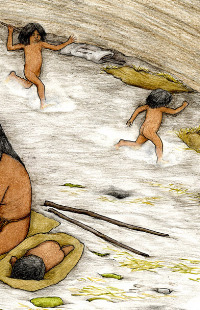
Artist's rendering of a child playing inside Hinds Cave. The material culture of children is often ignored by archeologists, but children added significantly to, and probably disturbed, the archeological record. Drawing by Peggy Maceo. |

Grass layer representing a sleeping bed exposed in trench wall. TAMU Anthropology archives. |

The flat, thin lenses seen most clearly on the left side of this close-up photograph are layer after layer of urine-compacted soil. The dark and light bands represent ash, charcoal and other living debris compacted by the repeated use of this area of the shelter as a latrine.This photo, taken late in the 1976 season, depicts the lower deposits in the south wall of Block B as exposed during the excavation of the north half of the block. TAMU Anthropology archives. |
| |
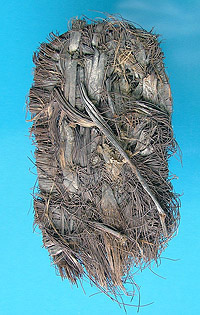
Worn-out sandals were often recycled as padding for sleeping beds. TAMU Anthropology archives. |
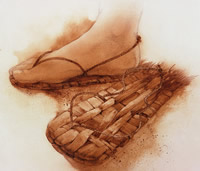
Sandals were perhaps the most essential item of clothing for native peoples living in the rough terrain of the Lower Pecos Canyonlands. Drawing by George Strickland, courtesy of the Witte Museum. |
| |

Below freezing temperatures, such as occurred on the winter day this photo was taken, reminds us that people had to survive year-round in the seemingly harsh environment of the Lower Pecos with only what nature and their own technology could provide. TAMU Anthropology archives. |

Ripe tunas. Prickly pear fruit, known as tunas or pears, begins to ripen in late summer to a deep red color and produces a very sweet, yet otherwise tasteless, purple-red juice. The tunas are eaten by many animals as well as people.
|

Cooked lechuguilla. Properly prepared, the lower leaves and the central stalk are sugary sweet and no longer contain toxins and soapy compounds. The taste is intensely sweet and a bit smoky. Photo by Phil Dering.
|
|
